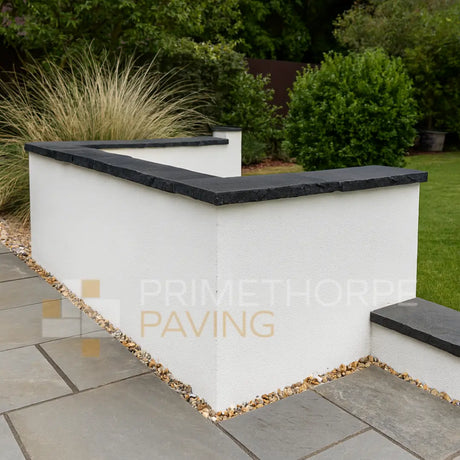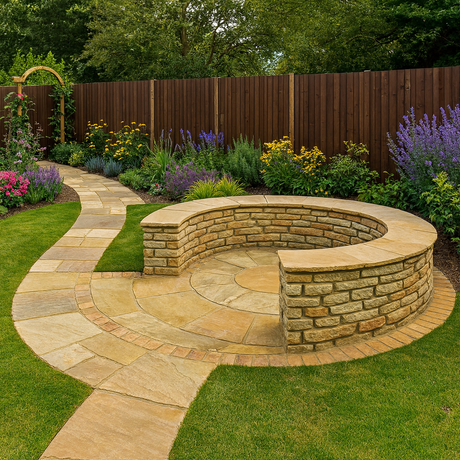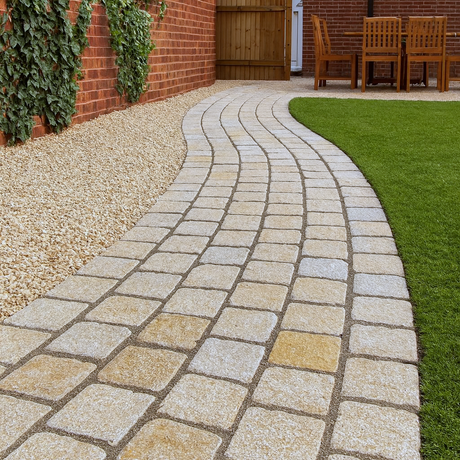We at Primethorpe Paving receive numerous queries on how to clean cement stains off black limestone. One of the most commonly used materials for outdoor paving, black limestone creates a stunning, versatile, and durable patio. However, a significant number of homeowners and DIY enthusiasts find themselves facing an unwelcome sight after the installation - a residual white haze, often termed "picture framing." This is usually caused by cement residue left on the slabs during the jointing process.
But rest easy, because we are here to provide you with the step-by-step guide you need to restore your black limestone to its original glory.

In this post, we will explore the world of black limestone, discuss why cement jointing might lead to stains, and introduce you to a great alternative: jointing compounds. Then, we'll walk you through a detailed, easy-to-follow process on how to remove cement stains from your precious stone without causing any damage. Stay with us, your limestone slabs are about to get a whole new lease on life.
Black Limestone, Cement Jointing, and the Dilemma of Cement Stains
Before we delve into how to resolve the issue of cement stains, it's important to understand why this problem commonly occurs. Black limestone is a captivating, yet porous material, making it a sought-after choice for homeowners and landscapers alike. It’s a natural stone that boasts a rich, deep black colour when wet or sealed, providing a touch of sophistication and elegance to any outdoor space.
When installing black limestone, a common method used to secure the slabs is cement jointing. This process involves spreading a mixture of cement and sand to fill the gaps between the slabs, ensuring a solid, stable paving surface. However, during installation, cement can often end up on the face of the slabs. When this cement residue dries, it can lead to a frustratingly common issue known as "picture framing." Picture framing refers to the cement-stained edges around the slab, which resemble a frame – not quite the artistic touch most of us are after for our garden spaces!
The key to avoiding this scenario altogether is using jointing compounds instead of traditional cement. These wonderful products can prevent staining during the pointing process as they don't contain cement. But what if your black limestone is already installed and you're faced with the eyesore of cement stains? Let's tackle that head-on in the next section with a comprehensive guide on how to remove these stains without damaging your stone.

How to Remove Cement Stains from Your Black Limestone Slabs
Cleaning cement stains from black limestone paving is a task that requires care and patience. It's essential to use an alkaline cleaning product specifically designed for natural stones. This will ensure the safety of your slabs during the cleaning process. Below, we present a step-by-step guide on how to achieve this:
Note: Always wear protective gloves and eyewear while handling cleaning solutions.
- Choose the Right Cleaning Product: The first step is to choose an alkaline cleaning product specifically designed for removing cement stains from natural stone. Remember, it's crucial to avoid any acid-based cleaners (more on that in the next section).
- Prepare the Cleaning Solution: Dilute the cleaning product according to the manufacturer's instructions. Be sure to read these instructions carefully, as the correct dilution ratio is vital for effective cleaning without damaging the stone.
- Scrub Carefully: Next, apply the cleaning solution to the cement stains on your black limestone paving. Use a soft scrubbing brush or a nylon pad to gently scrub the affected area. It’s important to scrub delicately to avoid scratching the surface of your beautiful slabs. A circular motion often works best, helping to lift the cement residue without causing any damage.
- Rinse and Repeat: Once you've scrubbed the stain, rinse the area thoroughly with clean water. If the stain is still visible, repeat the process until you've completely removed the cement residue. Be patient – it might take a few rounds of cleaning to get your limestone looking its best again.

The Cardinal Rule: Never Use Acid on Your Limestone Slabs
In the world of stone cleaning, there are a few cardinal rules, and this is one of them: never, under any circumstances, use acid on your limestone slabs. If you take one thing away from this guide, let it be this.
Limestone, including your stunning black limestone slabs, is predominantly made up of calcium carbonate. When acid meets calcium carbonate, they react violently, causing the limestone to effervesce or fizz. It might sound harmless, but the effects are anything but.
This fizzing is actually the acid eating away at the limestone. In other words, your paving slabs are being damaged, often irreparably. The acid can lead to discoloration, pitting, and a general dullness that takes away from the natural beauty of the stone. This damage is permanent; once done, there is no way to restore the original state of the stone.
So, resist the temptation to use any acid-based cleaners, no matter how stubborn the cement stains may seem. As explained in the previous section, an alkaline cleaning solution will do the job without the disastrous side effects.

Safeguard Your Slabs: Opt for Jointing Compounds
If you're here to seek advice before pointing your paving, then you're in luck. There's a hassle-free, and stain-free solution that can save you from the ordeal of cement staining: jointing compounds.
Jointing compounds are a modern, efficient alternative to the traditional cement/mortar joint. Made up of a mix of polymers and aggregates, these compounds do not contain cement, and thus, will not cause those notorious cement stains.

What's more, using a jointing compound can be an easier and quicker process than using mortar. Once you've prepared the compound, it's just a matter of applying it to the joints, compacting it, and sweeping off the excess. No need for endless scrubbing or the fear of permanent staining.
Here at Primethorpe Paving, we offer a selection of quality jointing compounds suitable for your black limestone paving. These products have been selected for their superior performance, ease of use, and outstanding results.
Repointing your paving? The same rule applies. When rejuvenating your black limestone, opt for a jointing compound over a mortar mix. You'll appreciate the cleaner finish and the peace of mind that comes with knowing you've avoided potential staining problems.
That's it. You're now armed with the knowledge to prevent and tackle cement stains on your black limestone paving. Remember, the secret is in the preparation and the product choice. By choosing quality materials and following good practice, you can ensure your outdoor space stays as stunning as the day it was laid.
Conclusion: Safeguard Your Black Limestone Paving
Your black limestone paving can be the envy of all your neighbours, with its unique, stylish appearance. But keeping it at its best requires knowledge and the right products.
For those who have already faced the cement-stain crisis, remember to avoid acid at all costs, use an alkaline-based cleaner and a bit of elbow grease. For those still in the planning stages, consider jointing compounds as your go-to for a hassle-free, stain-free finish. We hope this guide helps you enjoy your beautiful black limestone paving for years to come.
Understanding the nuances of this gorgeous stone, especially its sensitivity to cement and acid, will help you avoid the pitfalls that can lead to unsightly staining. Always remember to carefully clean cement residues with an alkaline-based cleaner, taking care not to scrub too hard to avoid marking the stone.
Better still, prevent these issues from the get-go. Choose a jointing compound rather than a traditional cement/mortar joint. Jointing compounds guarantee a cleaner finish, free from the risk of cement staining, allowing you to enjoy your beautifully laid paving without worry.
We pride ourselves on our comprehensive range of high-quality products and our commitment to ensuring you have the best for your landscaping needs. Whether you're in the planning phase or already own a lovely black limestone patio, we're here to help you keep it looking its best.
For more information on our products and more handy guides like this one, keep following our blog. Happy gardening, and remember: your outdoor space is a reflection of your style – keep it beautiful, stain-free, and inviting.
Remember, if you have any questions or need further assistance, don't hesitate to reach out to our team at sales@primethorpepaving.co.uk, or call us on 01733 810161.






